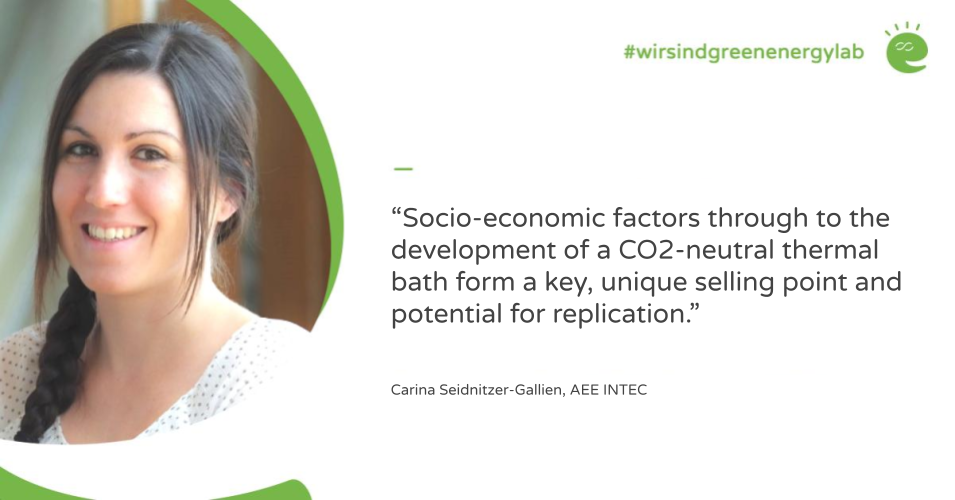GEO.MAT
Increasing the efficiency of geothermal energy systems with heat pump technologies
The Austrian thermal landscape is one of the most important tourist regions in Europe. In addition to the high number of visitors, the thermal baths also have a high energy consumption. The problem is that the energy required currently still comes to a large extent from fossil sources such as gas. Fortunately, there is also a great potential for the use of deep hydrothermal geothermal energy (depth > 400m) in the thermal landscape, which must be exploited. The decarbonization of thermal baths can therefore make a valuable contribution to the energy transition.
The use of renewable energy in the thermal spa landscape is much easier than in urban centers. The CO₂ reduction potential is more than considerable and amounts to an average of 50,000 tons of CO₂ per year for all thermal baths. The CO₂ reduction potential is also so significant because the so-called splash water from the pool, with a relatively high temperature level (30°C), is still unused in most thermal baths in terms of energy.
Objective of the GEO.MAT project
GEO.MAT is pursuing the goal of using hydrothermal wastewater to generate energy by means of heat pumps instead of flushing it down the drain. The project aims to fully exploit the existing potential. This is to be achieved by integrating heat pumps that treat the waste (surge) water and thus make it usable again. Efficiency improvements are also being sought through control measures. Replacing existing pipes and heat exchangers with innovative components should lead to further energy savings. “GEO.MAT” is also intended to create flexibility for heat and electricity grids. The extensive catalog of measures is to be implemented at two demonstration locations, the H2O Therme in Bad Waltersdorf and the Sonnentherme Lutzmannsburg. The solutions developed are aimed at a high replication potential for other thermal baths.
Approach and methodology of the GEO.MAT project
In the GEO.MAT project, various heat pump technologies that are used to upgrade the geothermal waste (surge) water (30°C) and to heat the pools of thermal spas are coupled with innovative control measures for demand-side management (peak shaving, load shifting) and supply-side management (load point-optimized use), and energy-optimized pipelines and heat exchangers are being developed for Austrian thermal spas, taking into account the low target temperatures for pool heating. Easily reproducible integration concepts and a roadmap for nationwide deployment will be derived from the planning and operation of these demo sites in order to increase market acceptance.
By designing integrated systems that can simultaneously generate and consume different forms of energy (heating, cooling, electricity) and coupling them with thermal capacities in buildings and in the service sector (hotels, spa areas, service areas, swimming pools), a high degree of flexibility can be provided for thermal and electrical grids alike. To exploit this potential, compression and absorption heat pumps are used in digitized energy management systems with the help of state-of-the-art interfaces between model and data-predictive control to maximize overall efficiency (demand and supply side) and decarbonization of the respective overall system. Due to the representative composition of the project consortium, which covers the entire value chain, all of the following research questions and integration aspects can be solved:
- special self-cleaning heat exchanger (prevents fouling and clogging)
- industrial (absorption and compression) heat pump systems,
- transient component design
- load shifting measures using the flexibility of the pools
- sector coupling
- business models
More than 30 % of the heat requirement can be saved simply by upgrading the waste water heat via heat pumps and using the flexibility of the thermal bath systems. However, the GEO.MAT concept goes one step further and also includes a solution to cover the remaining demand with renewable waste heat, for example from biomass or solar. However, this locally available waste heat must be used internally for energy supply, as it also conserves biomass resources and land in Austria. In addition, for socio-economic reasons, guests will pay more and more attention to their ecological footprint and prefer products, services and entertainment offerings that support this concern. In this context, increasing energy efficiency and becoming a CO₂-neutral thermal spa could be a unique selling point (e.g. “green thermal spa”). The result of this important project for the energy transition offers a solution for a CO₂-neutral and gas-free energy supply for thermal baths, with a high replication potential in Austria and Central Europe.




